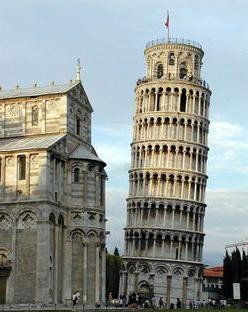Author's Note: I've decided to shorten the name "Remarkable Places of the World" in order for me to include the name of the structures in the title.

Height: 55.6 m (183.27 ft) on lowest side
56.70 m (186.02 ft) on highest side
Width: 4.09 m (13.42 ft) at the base
2.48 m (8.14 ft) at the top
The Torre pendente di Pisa, or Leaning Tower of Pisa, is a freestanding bell tower in Pisa, Italy. It was meant to stand vertically, but the poorly laid foundation and loose substrate caused the tower to lean at an angle of 3.79 degrees southeast.
The Building of the Tower
It took almost 177 years to build the Tower. In 1173, the first floor was built. It wasn't until 1178 when the Tower began to topple after construction reached the third floor. The design was imperfect from the beginning, due to foundation set in frail and unsteady subsoil. Construction was then left aside for about 90 years, while the Pisans were in continuous battles with the Lucca, Genoa, and Florence. During those times, the soils were able to straighten out, or else, the Tower wouldn't have been able to stand for very long.
In 1272, Giovanni Di Simone carried on with the construction. This time, the engineers built higher floors, one side taller than the other. Because of that, the tower began to lean in the opposite direction. After the Pisans were defeated by the Genoans in the Battle of Meloria, construction was shut down again in 1284.
The seventh floor was finally finished in 1319, but the bell-chamber wasn't added until 1372.
Did You Know?
- No one knows for sure who the real architect of the Leaning Tower of Pisa is. For a long time, the recognition went to Bonanno Pisano, an Italian sculptor. His casket was discovered at the base of the Tower in 1820.
- Diotisalvi was also believed to be the real architect, because of the time of construction and the resemblance with other works of his. Nevertheless, Diotisalvi usually signed his works, and there was no signature of his in the Tower.
- Galileo Galilei was believed to have dropped two cannon balls on the tower to display that their descending speed depended on their mass. The only proof of this event came from Galileo's secretary.
The 8-stories Leaning Tower of Pisa is not vertical, unlike most of the other recognizable structures of the world, and that is what's so remarkable about it.
Author's Note: Sources:
http://en.wikipedia.org/wiki/Leaning_tower_of_pisa
http://www.italyguides.it/us/pisa/leaning_tower.htm
http://www.britannica.com/EBchecked/topic/333926/Leaning-Tower-of-Pisa